


xxxxxThe Oxford Movement aimed
to inject a measure of Catholicism into the ailing Church of
England, hoping to revise the ritual and ceremony which had
characterised the early, undivided church. It saw the Anglican
Church as a middle way between Roman Catholicism and Protestantism.
The movement was sparked off in 1833 by a sermon given at Oxford
by the priest John Keble. In it he called for the revitalisation of
the Church on catholic lines. This cause was taken up by the
theologian John Henry Newman of Oxford. He became the movement’s
leader, editing the Tracts it produced, writing a large number of
them, and giving powerful sermons in its support. In 1841, however,
by suggesting that the Anglican and the Roman Catholic Churches had
compatible dogmas, he went a step too far. The movement was
condemned by the bishops, and Newman himself eventually became a
Roman Catholic. But the aims of the movement lived on under the
leadership of the Oxford professor of Hebrew, Edward
Pusey. He, together with Keble, maintained
the branch known as the High or Anglo-Catholic Church, and this
did much to bring a greater sense of purpose and commitment to the
Anglican Church of the day.
THE OXFORD MOVEMENT 1833 (W4)
Acknowledgements
Oriel: vintage
print, published in 1954, artist unknown. Keble:
by the English painter George Richmond (1809-1896), 1863 –
Metropolitan Museum of Art, New York. Newman:
by the English Pre-Raphaelite painter John Everett Millais
(1829-1896), 1881 – National Portrait Gallery, London. Smith: c1842, artist unknown – Community of Christ
Headquarters, Independence, Missouri, USA. Young:
by the British-born American artist Charles William Carter
(1832-1918), c1870 – Fine Arts Library, Fogg Museum, Harvard
Art Museums, Cambridge, Massachusetts. Temple:
completed in 1893, artist unknown. Darby:
date and artist unknown.
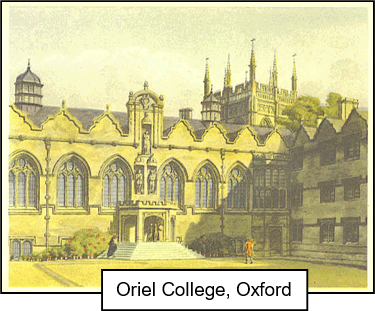 xxxxxThe movement for church reform and religious revival
within England which began in the early 1830s came to be known as
the Oxford Movement because it had its roots in Oxford University.
Its chief leaders had strong ties with the University, and three
were fellows of Oriel College. It aimed to inject a measure of
Catholicism into what it saw as an ailing Church of England,
emphasising the fact that the Church that had emerged from the
English Reformation still adhered to the apostolic succession
(bishops claiming descent from the apostles) and thereby still
remained a branch of the holy catholic (world-wide) church,
together with the Greek Orthodox and the Roman Catholic churches.
xxxxxThe movement for church reform and religious revival
within England which began in the early 1830s came to be known as
the Oxford Movement because it had its roots in Oxford University.
Its chief leaders had strong ties with the University, and three
were fellows of Oriel College. It aimed to inject a measure of
Catholicism into what it saw as an ailing Church of England,
emphasising the fact that the Church that had emerged from the
English Reformation still adhered to the apostolic succession
(bishops claiming descent from the apostles) and thereby still
remained a branch of the holy catholic (world-wide) church,
together with the Greek Orthodox and the Roman Catholic churches.
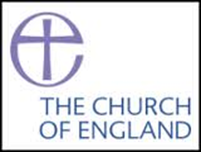 xxxxxIts adherents also feared that the Church of England
was becoming dominated by the secular authorities and it was,
indeed, this issue that sparked off the movement. In a sermon
entitled On the National
Apostasy in July 1833, the
speaker, the theologian John Keble, referred to the recent attempt
by Parliament to abolish ten bishoprics in Ireland, and warned the
Anglican Church against abandoning its faith (the meaning of apostasy). There followed a meeting of the
leaders, united in their support for the principles enshrined in the
Book of Common Prayer, and in the September a series of pamphlets or
theological treatises was begun setting out the movement’s aims.
Known as Tracts for the Times, ninety
were produced over the next eight years, urging above all for a
revitalisation of the English Church in order that it might be the
middle way (via media) between Roman
Catholicism on the one hand and Protestantism on the other. No less
than 24 were written by the movement’s leader, the theologian John
Henry Newman. He also edited the series and, as vicar of the
university’s church, made a major contribution by his learned weekly
sermons. By the late 1830s, however, the movement was arousing some
serious opposition. Its writings were becoming so sympathetic
towards Roman Catholicism that the bishops came out openly against
the movement. The final split came in February 1841 when a tract by
Newman, number 90, asserted that the Anglican Thirty-nine
Articles had much in common with Roman Catholic beliefs. This was
seen as undermining the very
xxxxxIts adherents also feared that the Church of England
was becoming dominated by the secular authorities and it was,
indeed, this issue that sparked off the movement. In a sermon
entitled On the National
Apostasy in July 1833, the
speaker, the theologian John Keble, referred to the recent attempt
by Parliament to abolish ten bishoprics in Ireland, and warned the
Anglican Church against abandoning its faith (the meaning of apostasy). There followed a meeting of the
leaders, united in their support for the principles enshrined in the
Book of Common Prayer, and in the September a series of pamphlets or
theological treatises was begun setting out the movement’s aims.
Known as Tracts for the Times, ninety
were produced over the next eight years, urging above all for a
revitalisation of the English Church in order that it might be the
middle way (via media) between Roman
Catholicism on the one hand and Protestantism on the other. No less
than 24 were written by the movement’s leader, the theologian John
Henry Newman. He also edited the series and, as vicar of the
university’s church, made a major contribution by his learned weekly
sermons. By the late 1830s, however, the movement was arousing some
serious opposition. Its writings were becoming so sympathetic
towards Roman Catholicism that the bishops came out openly against
the movement. The final split came in February 1841 when a tract by
Newman, number 90, asserted that the Anglican Thirty-nine
Articles had much in common with Roman Catholic beliefs. This was
seen as undermining the very independence of the Church of England. The tract was condemned out
of hand and, following the intervention of the Bishop of Oxford, no
further treatises were published.
independence of the Church of England. The tract was condemned out
of hand and, following the intervention of the Bishop of Oxford, no
further treatises were published.
xxxxxSuch
was the strength of the movement, however, that a large number of
Anglican clergy resigned, and became
members of the Roman Catholic Church. They were joined by Newman
himself in 1845. And there were many other clergy who, whilst
remaining as Anglicans, became known as Anglo-Catholics or
High-church members, adopting much of the ceremony and ritual
associated with the Roman Catholic Church - such as the use of
incense and the introduction of the confessional. The Oxford
Movement resulted in a religious upheaval, nothing less, but it did
much to revitalise and transform the Church at this time. It
inspired its ministers, reawakened interest in religious matters,
and, in the long term, revived the part played by the early church
in the everyday welfare of its people.
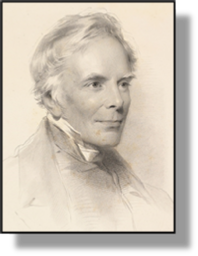 xxxxxThe Anglican priest and poet John
Keble (1792-1866), the man whose
sermon sparked off the Oxford Movement, was born in Fairford,
Gloucestershire. He attended Corpus Christi College, Oxford, and was
fellow and tutor of Oriel College from 1811 to 1823. A religious
poet of some standing, he became professor of poetry at Oxford in
1831, and it was then that he became involved with others in seeking
church reform. His sermon of 1833 is
generally regarded as the start of the Oxford Movement. He wrote
four Tracts for the Times,
and, together with Edward Pusey, remained an active leader after
John Newman became a Roman Catholic. He was vicar of Hursley in
Hampshire as from 1835, and remained there for the rest of his life.
His most successful poetic work was The
Christian Year of 1827. Keble College, Oxford, was founded
in his memory in 1869, three years after his death.
xxxxxThe Anglican priest and poet John
Keble (1792-1866), the man whose
sermon sparked off the Oxford Movement, was born in Fairford,
Gloucestershire. He attended Corpus Christi College, Oxford, and was
fellow and tutor of Oriel College from 1811 to 1823. A religious
poet of some standing, he became professor of poetry at Oxford in
1831, and it was then that he became involved with others in seeking
church reform. His sermon of 1833 is
generally regarded as the start of the Oxford Movement. He wrote
four Tracts for the Times,
and, together with Edward Pusey, remained an active leader after
John Newman became a Roman Catholic. He was vicar of Hursley in
Hampshire as from 1835, and remained there for the rest of his life.
His most successful poetic work was The
Christian Year of 1827. Keble College, Oxford, was founded
in his memory in 1869, three years after his death.
xxxxxIncidentally, the Oxford Movement was first known as the Tractarian
or Catholic Revival Movement. After Newman left to join the Roman
Catholic Church, Edward Bouverie Pusey (1800-1882), professor of Hebrew at Oxford,
became the leader of the High Church party within the Anglican
church, and members were then often known as “Puseyites”. It was
largely due to him, and Keble, that the movement’s aims were
preserved and its influence maintained and expanded. Pusey House at
Oxford was founded in his memory. It contains his library, and aims
to further his work.
Including:
John Henry Newman
and The Mormon
Church

W4-1830-1837-W4-1830-1837-W4-1830-1837-W4-1830-1837-W4-1830-1837-W4-1830-1837-W4
xxxxxThe influential theologian
John Henry Newman
(1801-90) was the acknowledged leader of the Oxford Movement.
He edited its series of religious treatises, the Tracts
for the Times, wrote a large number of them himself, and,
as vicar of St. Mary’s, the university’s church, used the pulpit to
get his message across. One of his tracts in 1841, however, by
suggesting that the doctrines of the Anglican and Roman Catholic
Churches were virtually compatible, brought condemnation by the
bishops. He retired from his living, joined the Roman Catholic
Church in 1845, and was made a cardinal in 1879. In the meantime, as
rector of Dublin University he gained a reputation for his lectures
on education. His masterpiece was Apology for
His Life, an eloquent account of his own spiritual
development.
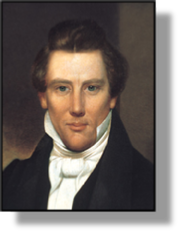 xxxxxThexChurch of Jesus Christ of
Latter-day Saints - a Christian sect generally known as
the Mormon Church
- was founded at Fayette, New York, in 1830 by the movement’s
prophet, Joseph Smith
(1805-1844). He claimed that he began receiving visions of God
and Jesus Christ from the age of 14, and that they had tasked him
with restoring Christ’s Church on earth. Revealed to him at this
time was the Book of Mormon,
a sacred record which was inscribed on golden plates. Written by
Mormon, an ancient prophet of North America, it provided a history
of a band of Hebrews who had migrated from Jerusalem to the New
World around 600 BC and, like the Israelites of the Old Testament,
had been chosen by God to fulfil His purpose. With the aid of two
sacred stones, he was able to translate this book, and it became
accepted by his Church as a vital part of their scriptures. He was
not permitted, however, to retain the golden plates or the sacred
stones.
xxxxxThexChurch of Jesus Christ of
Latter-day Saints - a Christian sect generally known as
the Mormon Church
- was founded at Fayette, New York, in 1830 by the movement’s
prophet, Joseph Smith
(1805-1844). He claimed that he began receiving visions of God
and Jesus Christ from the age of 14, and that they had tasked him
with restoring Christ’s Church on earth. Revealed to him at this
time was the Book of Mormon,
a sacred record which was inscribed on golden plates. Written by
Mormon, an ancient prophet of North America, it provided a history
of a band of Hebrews who had migrated from Jerusalem to the New
World around 600 BC and, like the Israelites of the Old Testament,
had been chosen by God to fulfil His purpose. With the aid of two
sacred stones, he was able to translate this book, and it became
accepted by his Church as a vital part of their scriptures. He was
not permitted, however, to retain the golden plates or the sacred
stones.
xxxxxAfter founding the sect in
1830 and gathering converts, he made a settlement at Kirtland, Ohio
the following year. He became the first president, and twelve
apostles were appointed in 1835, but there then followed a period of
persecution. Opposition by local inhabitants and money problems
forced the Mormons to make a move, first to Jackson County, Missouri
in 1837, and then, two years later, to Commerce (renamed Nauvoo) in
Illinois. Here he sought election as the U.S. president and became
involved in political conflict and intrigue. It was while in prison
in Carthage in 1844, charged with treason and conspiracy, that he
and his brother, Hyrum, were assassinated.
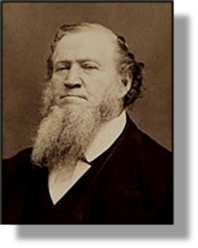 xxxxxHexwas succeeded as president
by Brigham Young
(1801-1877). He
saw the need to establish an independent settlement, and so led the
majority of Mormons, some 80,000, on an epic trek westward in search
of the “promised land”. After a journey of over l,000 miles they
reached Utah and established their new centre at Salt Lake City.
Here they built their temple (illustrated
below) and set up a thriving and expanding
community. But not all the Mormons migrated. Some remained in the
Midwest and accepted Joseph Smith’s son, also Joseph, as their
spiritual leader, adopting the name “Reorganised Church of Jesus
Christ of Latter-day Saints”.
xxxxxHexwas succeeded as president
by Brigham Young
(1801-1877). He
saw the need to establish an independent settlement, and so led the
majority of Mormons, some 80,000, on an epic trek westward in search
of the “promised land”. After a journey of over l,000 miles they
reached Utah and established their new centre at Salt Lake City.
Here they built their temple (illustrated
below) and set up a thriving and expanding
community. But not all the Mormons migrated. Some remained in the
Midwest and accepted Joseph Smith’s son, also Joseph, as their
spiritual leader, adopting the name “Reorganised Church of Jesus
Christ of Latter-day Saints”.
xxxxxThe latter-day Saints
are Christians but with some modification to their beliefs. They
base their doctrine on four basic books, the Bible,
the Book of Mormon, the Doctrine
and Covenants (mostly revelations and pronouncements by
Joseph Smith) and the Pearl of Great Price,
a work alleged to include two lost books of the Bible, those of
Abraham and Moses. Personal revelation also plays an important part
in their belief. There are two orders of priesthood, one dealing
with religious concerns, and the other with temporal matters.
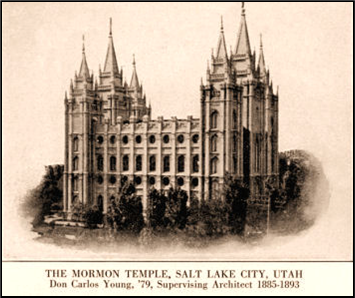 xxxxxMormons follow a strict moral code. They are forbidden
alcohol and tobacco, and do not believe in abortion and birth
control. Much emphasis is placed on family life. At one time their
leader, Smith, prompted by divine revelation, introduced polygamy.
This brought the Church into disrepute and stirred up much
controversy. The practice was ended in 1890. Today the Church has a
world-wide membership of some seven million (possibly more),
with well over half in the United States. It conducts a wide welfare
programme, and has missionaries working in over 160 countries.
xxxxxMormons follow a strict moral code. They are forbidden
alcohol and tobacco, and do not believe in abortion and birth
control. Much emphasis is placed on family life. At one time their
leader, Smith, prompted by divine revelation, introduced polygamy.
This brought the Church into disrepute and stirred up much
controversy. The practice was ended in 1890. Today the Church has a
world-wide membership of some seven million (possibly more),
with well over half in the United States. It conducts a wide welfare
programme, and has missionaries working in over 160 countries.
xxxxxIncidentally,
the name “Latter-day Saints” comes from the belief that, the
early Church having failed in its mission, the Mormons are the
apostles of the latter days, beginning with their establishment as a
church in 1830. ……
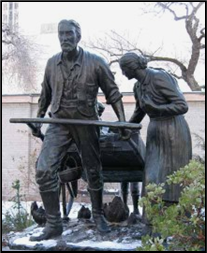 xxxxx…… In 1857, after the Mormons
had been implicated in the Mountain Meadows Massacre - the
slaughter of a group of Arkansas emigrants - federal troops were sent to Utah in what came to be
known as the Utah War. No fighting occurred, in fact, but religious
conflict continued between the Mormons and their hostile neighbours.
……
xxxxx…… In 1857, after the Mormons
had been implicated in the Mountain Meadows Massacre - the
slaughter of a group of Arkansas emigrants - federal troops were sent to Utah in what came to be
known as the Utah War. No fighting occurred, in fact, but religious
conflict continued between the Mormons and their hostile neighbours.
……
xxxxx……
Shown here is one of the statues at Salt Lake city depicting the
long trek across America in the 1850s. Some 3,000 pioneers, lacking
the necessary money for ox or horse teams, had to make the journey
by pulling handcarts. The vast majority did not make it to the
promised land.
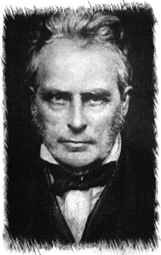
xxxxxItxwasxin 1831, soon after the Mormon Church was established,
that the Christian sect known as the
Plymouth Brethren
organised their first church at Plymouth, England. It was actually
founded in Dublin during the 1820s, and became noted for its extreme
simplicity of belief. This included a literal interpretation of the
bible and a second coming - a sudden “secret rapture” that
would take the faithful to heaven. The movement spread to the United
States and to Europe, where its members became known as “Darbyites”
after one of the sect’s prominent leaders, the Anglo-Irish
evangelist John Nelson Darby (1800-1882) (illustrated). Prayer and bible study meetings are held in members’
homes and there are no official clergy. This lack of centralised
authority has led to a number of break-away sects over the
years. World-wide membership is estimated at 1.5 million.
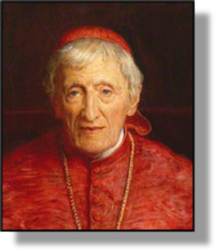 xxxxxThe influential theologian John
Henry Newman (1801-1890), who ended
his career as a Roman Catholic cardinal, was the Oxford Movement’s
acknowledged leader. He was educated at Oxford, and became a fellow
of Oriel College in 1822. He was ordained in the Church of England
two years later, and became vicar of St. Mary’s, the university’s
Anglican Church, in 1827. Anxious to see a return to the ceremony
and worship of the early, undivided church, he was a founder member
of the movement, and became highly active in its cause, editing the
Tracts, writing nearly a third of them, and making good use of his
pulpit each week for close on eight years.
xxxxxThe influential theologian John
Henry Newman (1801-1890), who ended
his career as a Roman Catholic cardinal, was the Oxford Movement’s
acknowledged leader. He was educated at Oxford, and became a fellow
of Oriel College in 1822. He was ordained in the Church of England
two years later, and became vicar of St. Mary’s, the university’s
Anglican Church, in 1827. Anxious to see a return to the ceremony
and worship of the early, undivided church, he was a founder member
of the movement, and became highly active in its cause, editing the
Tracts, writing nearly a third of them, and making good use of his
pulpit each week for close on eight years.
xxxxxHis last tract of 1841 -
and the final one as it turned out - brought stringent
opposition from church leaders, suggesting as it did that the
Anglican Thirty-Nine Articles were virtually compatible with
Roman Catholic beliefs. Seeing no hope of achieving the reform he
considered necessary, he became a Catholic in 1845 and was made a
cardinal in 1879. In between times he was rector of Dublin
University, and gained a reputation for his lectures on education.
His masterpiece was Apology for His Life, an eloquent account of his own spiritual
development. He was the author of the hymn Lead,
kindly light, and his poem The Dream of
Gerontius, which tells the journey of an
old man’s soul after death, was set to music by the English composer
Edward Elgar in 1900.
xxxxxThe Mormon Church - officially known as the Church of Jesus Christ
of Latter-day Saints - was established in New York by its
leader and prophet Joseph Smith in 1830. He claimed that God had
appeared to him and charged him with the task of restoring Christ’s
church on earth. To this end he was given a translation of the Book of Mormon, the work of an ancient
prophet. This gave an account of a band of Hebrews who had journeyed
from Jerusalem to the New World around 600 BC and, like the
Israelites of the Old Testament, had been chosen by God to fulfil
His purpose on earth. Seeing himself as the modern leader of this
group, Smith made a settlement at Kirtland, Ohio, and attracted many
converts. However, he was forced to move a number of times because
of persecution, and he was eventually assassinated in Carthage,
Illinois, in 1844. The new leader, Brigham Young, realising the need
for a more independent settlement, led the vast majority of the
Mormons in a 1,000 mile trek to Utah in the west. Here, at Salt Lake
City in 1847 they set up their permanent home and temple. Today the
church has some seven million members world-wide, and supports
missions in over 160 countries. Essentially Christian in belief -
with some modifications - the Mormons follow a strict moral
code, emphasise the importance of family life, and regard personal
revelation as an important part of their belief.






 xxxxxThe movement for church reform and religious revival
within England which began in the early 1830s came to be known as
the Oxford Movement because it had its roots in Oxford University.
Its chief leaders had strong ties with the University, and three
were fellows of Oriel College. It aimed to inject a measure of
Catholicism into what it saw as an ailing Church of England,
emphasising the fact that the Church that had emerged from the
English Reformation still adhered to the apostolic succession
(bishops claiming descent from the apostles) and thereby still
remained a branch of the holy catholic (world-
xxxxxThe movement for church reform and religious revival
within England which began in the early 1830s came to be known as
the Oxford Movement because it had its roots in Oxford University.
Its chief leaders had strong ties with the University, and three
were fellows of Oriel College. It aimed to inject a measure of
Catholicism into what it saw as an ailing Church of England,
emphasising the fact that the Church that had emerged from the
English Reformation still adhered to the apostolic succession
(bishops claiming descent from the apostles) and thereby still
remained a branch of the holy catholic (world- xxxxxIts adherents also feared that the Church of England
was becoming dominated by the secular authorities and it was,
indeed, this issue that sparked off the movement. In a sermon
entitled On the National
Apostasy in July 1833, the
speaker, the theologian John Keble, referred to the recent attempt
by Parliament to abolish ten bishoprics in Ireland, and warned the
Anglican Church against abandoning its faith (the meaning of apostasy). There followed a meeting of the
leaders, united in their support for the principles enshrined in the
Book of Common Prayer, and in the September a series of pamphlets or
theological treatises was begun setting out the movement’s aims.
Known as Tracts for the Times, ninety
were produced over the next eight years, urging above all for a
revitalisation of the English Church in order that it might be the
middle way (via media) between Roman
Catholicism on the one hand and Protestantism on the other. No less
than 24 were written by the movement’s leader, the theologian John
Henry Newman. He also edited the series and, as vicar of the
university’s church, made a major contribution by his learned weekly
sermons. By the late 1830s, however, the movement was arousing some
serious opposition. Its writings were becoming so sympathetic
towards Roman Catholicism that the bishops came out openly against
the movement. The final split came in February 1841 when a tract by
Newman, number 90, asserted that the Anglican Thirty-
xxxxxIts adherents also feared that the Church of England
was becoming dominated by the secular authorities and it was,
indeed, this issue that sparked off the movement. In a sermon
entitled On the National
Apostasy in July 1833, the
speaker, the theologian John Keble, referred to the recent attempt
by Parliament to abolish ten bishoprics in Ireland, and warned the
Anglican Church against abandoning its faith (the meaning of apostasy). There followed a meeting of the
leaders, united in their support for the principles enshrined in the
Book of Common Prayer, and in the September a series of pamphlets or
theological treatises was begun setting out the movement’s aims.
Known as Tracts for the Times, ninety
were produced over the next eight years, urging above all for a
revitalisation of the English Church in order that it might be the
middle way (via media) between Roman
Catholicism on the one hand and Protestantism on the other. No less
than 24 were written by the movement’s leader, the theologian John
Henry Newman. He also edited the series and, as vicar of the
university’s church, made a major contribution by his learned weekly
sermons. By the late 1830s, however, the movement was arousing some
serious opposition. Its writings were becoming so sympathetic
towards Roman Catholicism that the bishops came out openly against
the movement. The final split came in February 1841 when a tract by
Newman, number 90, asserted that the Anglican Thirty- independence of the Church of England. The tract was condemned out
of hand and, following the intervention of the Bishop of Oxford, no
further treatises were published.
independence of the Church of England. The tract was condemned out
of hand and, following the intervention of the Bishop of Oxford, no
further treatises were published.  xxxxxThe Anglican priest and poet John
Keble (1792-
xxxxxThe Anglican priest and poet John
Keble (1792-
 xxxxxThexChurch of Jesus Christ of
Latter-
xxxxxThexChurch of Jesus Christ of
Latter- xxxxxHexwas succeeded as president
by Brigham Young
(1801-
xxxxxHexwas succeeded as president
by Brigham Young
(1801- xxxxxMormons follow a strict moral code. They are forbidden
alcohol and tobacco, and do not believe in abortion and birth
control. Much emphasis is placed on family life. At one time their
leader, Smith, prompted by divine revelation, introduced polygamy.
This brought the Church into disrepute and stirred up much
controversy. The practice was ended in 1890. Today the Church has a
world-
xxxxxMormons follow a strict moral code. They are forbidden
alcohol and tobacco, and do not believe in abortion and birth
control. Much emphasis is placed on family life. At one time their
leader, Smith, prompted by divine revelation, introduced polygamy.
This brought the Church into disrepute and stirred up much
controversy. The practice was ended in 1890. Today the Church has a
world- xxxxx…… In 1857, after the Mormons
had been implicated in the Mountain Meadows Massacre -
xxxxx…… In 1857, after the Mormons
had been implicated in the Mountain Meadows Massacre -
 xxxxxThe influential theologian John
Henry Newman (1801-
xxxxxThe influential theologian John
Henry Newman (1801-

